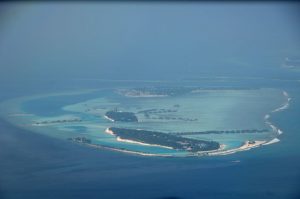The Indian Foreign Secretary Harsh V. Shringla began a two-day visit to the Maldives on November 9 as the country, with President Ibrahim Solih at the helm, continues to renew its traditional pro-India posture. Among the memorandums of agreement (MOUs) India and the Maldives have signed so far during Shringla’s visit includes one for a $100 million Indian grant to finance the Greater Male Connectivity Project (GCMP), Maldives’ biggest connectivity project of its kind thus far, and an “economic lifeline” for the country, as Shringla described it in his remarks at the Maldives foreign ministry.
Describing the GMCP, the Indian foreign secretary noted “the project will conform to the hallmarks of Indian development cooperation; transparency; full participation and ownership of the host country; and competitive pricing.” Interestingly, the accent on these features of Indian infrastructure finance is in line with a common stance key Indo-Pacific democracies — including Australia, Japan and the United States — are taking as a way to sharply differentiate their offerings from those through the Chinese Belt and Road Initiative.
In August this year, during a meeting between Indian External Affairs Minister S. Jaishankar and his counterpart Foreign Minister Abdulla Shahid, India committed to a $500 million dollar infrastructure package for the GCMP. The MOU for the $100 million grant signed earlier today is part of that package, with the rest being a line of credit for that project. India had also announced an additional aid package of $250 million for the Maldives in August, along with a commitment to build a direct cargo ferry service between the two countries.
The GCMP will connect “Male with Vilingili, the new commercial port at Gulhifalhu and industrial zone at Thilafushi,” Shringla reiterated.
As a sign of deepening ties with the Maldives – which was badly hit during President Abdulla Yameen’s term in office between 2013 and 2018 – Shringla announced that India will support Shahid’s candidature in election of the president of the United Nations General Assembly next year.
In his first foreign visit as prime minister for a second term, Narendra Modi travelled to the Maldives last June and co-inaugurated a coastal surveillance radar station built by India. Since coming to power in 2018, Solih has reaffirmed Male’s commitment to an “India First” foreign policy, after Yameen titled dangerously – as far as New Delhi was concerned – towards China. Officially, the Maldives owes $1.4 billion to China; unofficially, the figure is as high as $3.5 billion, or 70 percent of the Maldives’ GDP. Most of these are loans, incurred in the Yameen years, are through the Belt and Road Initiative.
But it is not just India that seeks to push against China’s influence in the island nation. The United States has also reached out to the Maldives. The two defense ministries of both countries signed a framework for a “Defense and Security Relationship” in September this year. Secretary of State Mike Pompeo also visited the Maldives as part of his South Asia trip last month and announced the establishment of a separate U.S. embassy in Male. (So far, the American ambassador to Sri Lanka enjoys concurrent accreditation to the Maldives.) Pompeo’s visit to the Maldives was a success, in sharp distinction to the snub he received in Sri Lanka.
What is exceedingly interesting about U.S. involvement in the Maldives is the way New Delhi – shedding its traditional shibboleths around the role of “external powers” in its backyard – has welcomed it this time around. According to a newspaper report, Washington had not only discussed its agreement with the Maldives with Indian officials in Male in its run-up but had also shared its draft with them.
In fact, it would not be too fanciful to imagine that the Maldives may very well be the country where one would see joint, or at the very least coordinated, efforts between the Quad countries in order to inoculate the strategically vital country against further Chinese encroachments.

































